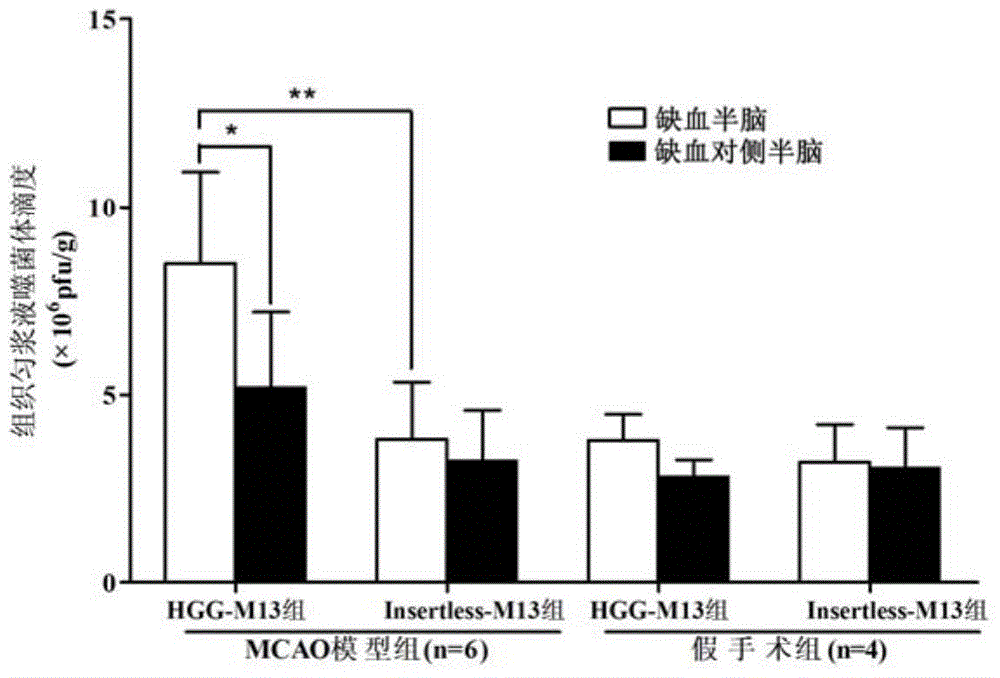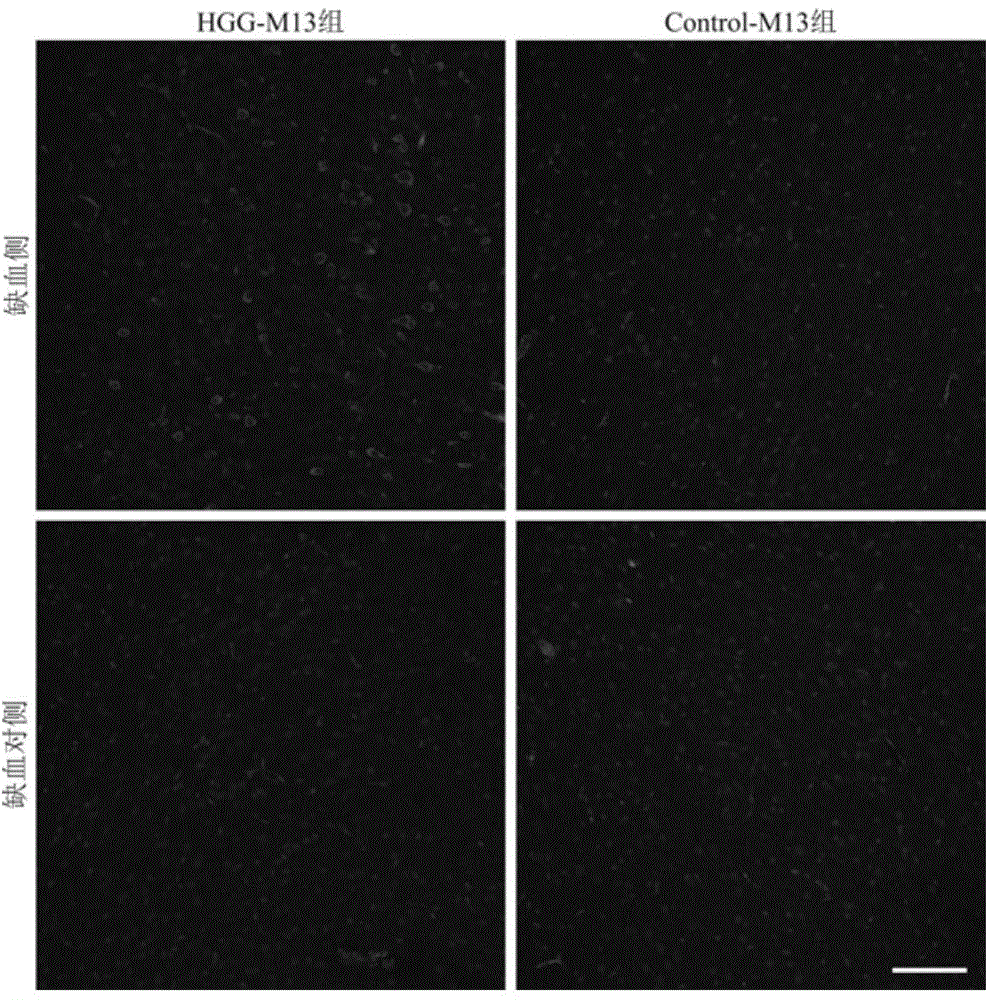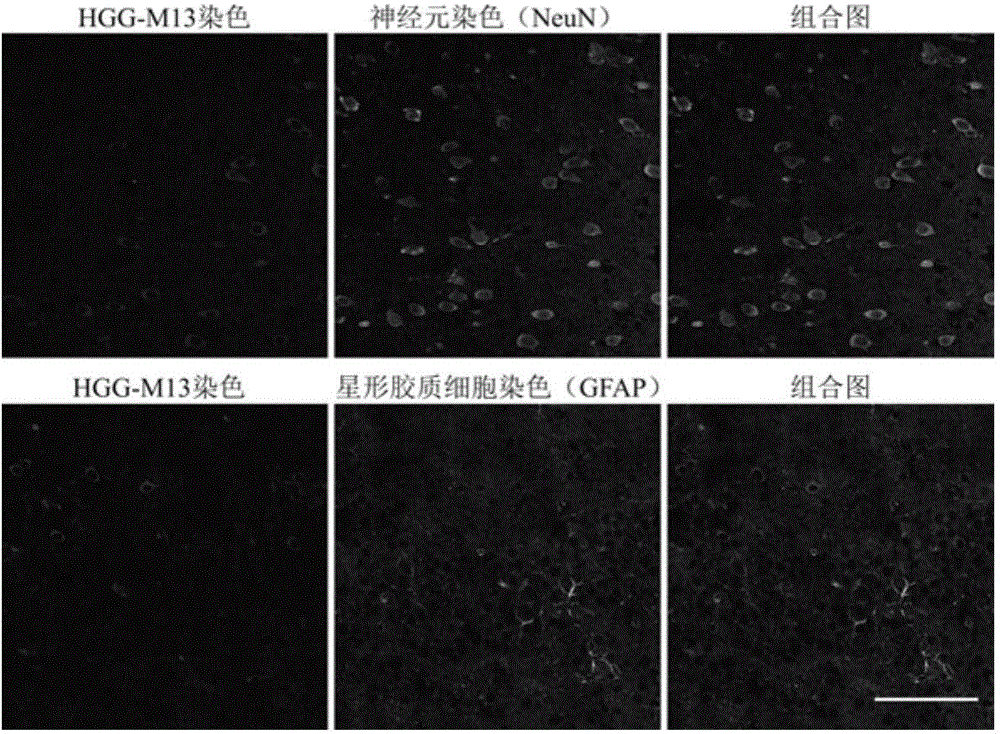HGG (Human Gammaglobulin) polypeptide in combination with tissue specificity of cerebral arterial thrombosis and application thereof
An ischemic stroke, tissue-specific technology, applied in the field of protein peptides, to achieve the effect of high activity, strong penetration, and enhanced neuroprotective effect
- Summary
- Abstract
- Description
- Claims
- Application Information
AI Technical Summary
Problems solved by technology
Method used
Image
Examples
Embodiment 1
[0055] Screening and preparation of embodiment 1 HGG polypeptide
[0056] This example uses in vivo phage display peptide library screening technology to obtain HGG polypeptides that specifically bind to ischemic stroke tissues. The specific steps are as follows:
[0057] 1. Construction of MCAO model: C57 mice were anesthetized by intraperitoneal injection of 0.4% sodium pentobarbital (40 mg / kg), fixed in supine position. A midline incision was made in the neck, the muscle and fascia were separated along the inner edge of the sternocleidomastoid muscle, and the right common carotid artery (CCA), external carotid artery (ECA) and internal carotid artery (ICA) were separated. Ligate the CCA at the proximal end and the ECA at the distal end, temporarily clamp the ICA with an arteriole clip, then cut a small opening at 2 mm from the bifurcation of the ECA, insert the tethered line into the ICA, and gently push the tethered line with fiber surgical forceps. Calculate the distance...
Embodiment 2
[0070] Example 2 Phage Monoclonal DNA Extraction and Sequence Determination
[0071] In this example, the DNA of 120 candidate phage monoclonals was extracted and sequenced.
[0072] After amplifying the monoclonal phage picked in Example 1, centrifuge to remove bacteria, take 500 μL of phage supernatant and add 200 μL PEG / NaCl, mix well and let stand on ice for 10 minutes, centrifuge at 14000 rpm at 4°C for 10 minutes, and resuspend the precipitate in 100 μL Add 250 μL of ethanol to iodide buffer, incubate at room temperature for 10 minutes, centrifuge for 10 minutes, discard the supernatant, wash the precipitate with 70% ethanol, briefly dry in vacuum, and resuspend the precipitate in 30 μL TE for sequencing.
[0073] All sequencing in this example was performed by BGI. The sequencing primer is -96gIII:5'- HO GTA TGG GAT TTT GCT AAA CAA C-3'.
[0074] The results of phage clone sequencing were analyzed by SeqMan software, and the base sequence was translated into amino ac...
Embodiment 3
[0075] Synthesis and fluorescence modification of embodiment 3 HGG polypeptide
[0076] The HGG polypeptide is artificially synthesized by Jill Biochemical (Shanghai) Co., Ltd. according to the amino acid sequence through chemical methods. The synthesized product was purified by high performance liquid chromatography (HPLC) and identified by mass spectrometry (MS). The purity of the polypeptide of the present invention is above 95%.
[0077] HGG polypeptide fluorescent labeling was completed by Gill Biochemical (Shanghai) Co., Ltd. The modification method is to add a lysine K at the -COOH end of the HGG peptide, which is connected to the 5-TAMRA fluorescent dye through its side chain amino group. The 5-TAMRA fluorescence-labeled peptide of the present invention is purified by high-performance liquid chromatography (HPLC), identified by mass spectrometry (MS), and the purity is above 95%.
PUM
| Property | Measurement | Unit |
|---|---|---|
| Hydrated particle size | aaaaa | aaaaa |
Abstract
Description
Claims
Application Information
 Login to View More
Login to View More - R&D
- Intellectual Property
- Life Sciences
- Materials
- Tech Scout
- Unparalleled Data Quality
- Higher Quality Content
- 60% Fewer Hallucinations
Browse by: Latest US Patents, China's latest patents, Technical Efficacy Thesaurus, Application Domain, Technology Topic, Popular Technical Reports.
© 2025 PatSnap. All rights reserved.Legal|Privacy policy|Modern Slavery Act Transparency Statement|Sitemap|About US| Contact US: help@patsnap.com



